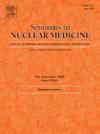PET Imaging in Psychiatric Disorders
IF 5.9
2区 医学
Q1 RADIOLOGY, NUCLEAR MEDICINE & MEDICAL IMAGING
引用次数: 0
Abstract
Positron emission tomography (PET) has emerged as a pivotal imaging modality in the investigation of psychiatric disorders, enabling in vivo assessment of regional cerebral metabolism, neurotransmitter dynamics, receptor binding, synaptic density, and neuroinflammation. This comprehensive review synthesizes current evidence on the utility of PET imaging in elucidating the pathophysiology of major psychiatric conditions—including schizophrenia, mood disorders, autism spectrum disorder, attention-deficit/hyperactivity disorder, and addiction and its potential in clinical decision-making. 18F-FDG-PET has consistently demonstrated regional metabolic abnormalities, most notably prefrontal hypometabolism in schizophrenia and major depressive disorder, with implications for negative symptomatology, cognitive dysfunction, and treatment resistance. Functional FDG-PET (fPET) has recently enabled dynamic metabolic mapping with high temporal resolution, allowing the evaluation of stimulus-induced changes in neuronal activity. Receptor-specific PET tracers have provided further insights into dopaminergic, serotonergic, glutamatergic, and GABAergic dysregulation across psychiatric spectra. Notably, schizophrenia is associated with a increased striatal dopamine (DA) synthesis capacity and DA release, and disrupted frontolimbic connectivity, while depression shows reduced serotonergic transporter binding and lower mGluR5 availability, supporting neurotransmitter system-based subtyping. PET imaging has also revealed neuroinflammatory signatures, such as altered TSPO binding, as well as synaptic density reductions via SV2A tracers in early psychosis, emphasizing shared neurobiological underpinnings and disease progression markers. In pediatric and neurodevelopmental disorders, including ASD, PET and multimodal approaches have contributed to identifying heterogeneous neurochemical phenotypes, linking abnormal glucose metabolism and receptor availability to specific behavioral domains. Clinically, PET imaging aids in the differential diagnosis of primary psychiatric disorders from neurodegenerative conditions, including behavioral variant frontotemporal dementia (bvFTD), by detecting disease-specific metabolic patterns and supporting biomarker-informed diagnostics. Furthermore, PET has been employed to predict and monitor treatment response across pharmacological and neuromodulatory interventions, including antidepressants, electroconvulsive therapy (ECT), and cognitive behavioral therapy (CBT), enabling strides toward personalized psychiatric care. Despite its promise, widespread clinical integration of PET in psychiatry remains limited by high cost, accessibility barriers, and the need for standardized acquisition and interpretation protocols. Ongoing advancements in radiopharmaceutical development, artificial intelligence, and normative imaging databases are expected to facilitate the incorporation of PET into routine psychiatric assessment and therapeutic planning. This review underscores the transformative role of PET in precision psychiatry and advocates for its expanded research and clinical application.
精神疾病的PET成像。
正电子发射断层扫描(PET)已成为研究精神疾病的关键成像方式,能够在体内评估区域脑代谢、神经递质动力学、受体结合、突触密度和神经炎症。这篇全面的综述综合了PET成像在阐明主要精神疾病的病理生理学方面的现有证据,包括精神分裂症、情绪障碍、自闭症谱系障碍、注意力缺陷/多动障碍、成瘾及其在临床决策中的潜力。18F-FDG-PET一直显示出区域代谢异常,最明显的是精神分裂症和重度抑郁症的前额叶代谢低下,与阴性症状、认知功能障碍和治疗抵抗有关。功能性FDG-PET (fPET)最近实现了高时间分辨率的动态代谢映射,可以评估刺激诱导的神经元活动变化。受体特异性PET示踪剂提供了进一步了解多巴胺能、血清素能、谷氨酸能和gaba能在精神光谱中的失调。值得注意的是,精神分裂症与纹状体多巴胺(DA)合成能力和释放能力增加以及额叶连通性中断有关,而抑郁症则表现出血清素能转运体结合减少和mGluR5可用性降低,支持基于神经递质系统的亚型。PET成像也揭示了神经炎症特征,如TSPO结合改变,以及通过SV2A示踪剂在早期精神病中突触密度降低,强调了共同的神经生物学基础和疾病进展标志物。在儿童和神经发育障碍中,包括ASD, PET和多模式方法有助于识别异质神经化学表型,将异常的糖代谢和受体可用性与特定的行为领域联系起来。临床上,PET成像通过检测疾病特异性代谢模式和支持生物标志物诊断,有助于神经退行性疾病(包括行为变异性额颞叶痴呆(bvFTD))的原发性精神疾病的鉴别诊断。此外,PET已被用于预测和监测药理学和神经调节干预的治疗反应,包括抗抑郁药、电痉挛疗法(ECT)和认知行为疗法(CBT),使个性化精神病学护理取得了长足的进步。尽管PET很有前景,但由于高昂的成本、可获得性障碍以及对标准化获取和解释协议的需求,它在精神病学中的广泛临床整合仍然受到限制。放射药物开发、人工智能和规范成像数据库的持续进步有望促进PET纳入常规精神病学评估和治疗计划。这篇综述强调了PET在精确精神病学中的变革性作用,并倡导其扩大研究和临床应用。
本文章由计算机程序翻译,如有差异,请以英文原文为准。
求助全文
约1分钟内获得全文
求助全文
来源期刊

Seminars in nuclear medicine
医学-核医学
CiteScore
9.80
自引率
6.10%
发文量
86
审稿时长
14 days
期刊介绍:
Seminars in Nuclear Medicine is the leading review journal in nuclear medicine. Each issue brings you expert reviews and commentary on a single topic as selected by the Editors. The journal contains extensive coverage of the field of nuclear medicine, including PET, SPECT, and other molecular imaging studies, and related imaging studies. Full-color illustrations are used throughout to highlight important findings. Seminars is included in PubMed/Medline, Thomson/ISI, and other major scientific indexes.
 求助内容:
求助内容: 应助结果提醒方式:
应助结果提醒方式:


